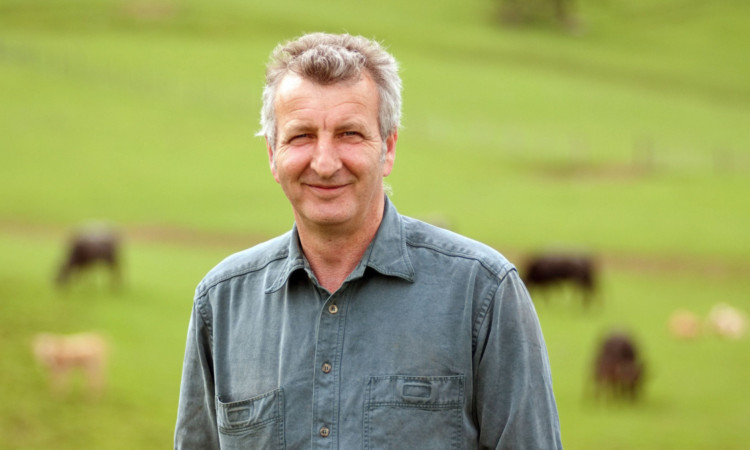Blue Grey suckler cows, out-wintered on common land on the edge of the North Yorkshire Moors, have created a profitable beef enterprise for producer Andrew Bell.
Andrew Bell switched to the hardy native breed cross the progeny of the Whitebred Shorthorn bull put to the Galloway cow 12 years ago from Continental cross sucklers. The 55-cow herd leaves a gross margin of almost £400 per cow producing Limousin- or Charolais-sired calves sold at six months old.
Inputs are minimal, fertility high and, because of the longevity of the Blue Greys, replacement costs stand at £25 a year.
Scarth Lees, near Northallerton, has been in the family since 1875 and in the 1930s it ran a herd of Galloway cows.
Andrew, with the help of wife Lorna and middle daughter Penny, who also works on neighbouring units, farms 180 acres of in-bye land, 60 of which is ploughable, and runs 25 spring-calving Blue Grey cows from November for five months on 300 acres of a National Trust owned common.
The common has public access to popular beauty spots Sheepwash and Cod Beck Reservoir and is crossed by the Cleveland Way and Lyke Wake Walk long-distance footpaths.
The moor, which runs up to 900ft and is very exposed to the east and weather coming off the North Sea, also has numerous archaeological sites, including Iron Age and Viking settlements.
“When I took over the farm in 1998 we used to run Limousin cross Hereford Angus cows, but I wanted a cow that I could outwinter and I bought some Blue Grey heifers in 2000 in Newcastleton,” said Andrew.
“It was costing too much to house the cows during the winter, particularly straw costs.”
The following year’s foot-and-mouth epidemic took the herd out, and Andrew used the opportunity to re-stock with Blue Greys, buying bulling and in-calf heifers and adding to numbers annually to build up numbers to today’s herd.
“The Blue Grey is the original suckler cow. Producers have lost their way with suckler cows and they are trying to farm them like dairy cows. Suckler cows traditionally lived on marginal and hill ground.
“It’s what you don’t spend on the cattle that makes you the money.
“Our oldest cows are now 13 years old and I would expect them to produce 15 calves in their lifetime.
“Our herd has been costed by SAC and over 12 years, selling a cull cow at £700 and buying in a replacement heifer at £1,000 gives a replacement cost of only £25 a year.”
“Continental-type cows are also too big for my system. I need a medium-sized, compact cow like the Blue Grey with a good constitution for outwintering, and when crossed with a quality Continental bull they can produce a top-specification calf,” said Andrew.
Andrew favours either a pedigree Limousin or Charolais bull to cross with the Blue Greys to produce a quality calf, with this year’s crop Charolais-sired.
Blue Grey replacements are purchased mainly as bulling heifers and a few in-calf heifers through Harrison & Hetherington.
Under the higher level stewardship agreement, only 25 cows can be outwintered on the common previously it was 40 with the remainder of the herd kept in a corral and cubicle housing.
Despite the common being a popular place for visitors and walkers year-round, the cattle do not cause any difficulties with people or dogs. In fact, the Blue Greys are part of the scenery and are well-photographed, with their images appearing on greetings cards.
Andrew believes that if the Blue Grey was included in the HLS native breeds supplement, which currently in England and Wales only covers pure native breeds rather than crosses, then breeders like himself would be able to invest more in making an even better job of producing their cattle for sale.
However, only having to house half the herd has cut back on the straw costs which were needed to winter the Continental cows previously straw was bought off 100 acres each year; now around 300 small straw bales are used over a winter.
Andrew reckons the out-wintered cows which put on a thick coat are much healthier and happier than those housed, and calving is more difficult in the cubicles.
There is additional work in scraping out and removing the manure.
The younger in-calf cows are on the common from November 1 to April 1 and they are fully hefted on the 300 acres of the 495-acre common.
Both lots of cows are supplemented with hay, those outside eating half as much as the housed cattle, until mid February, and a hard magnesium supplement to reduce the risk of grass staggers when they come back to the in-bye ground. If the winter is harsh they are fed rolls, but this is rare.
Calving is usually over a three-month period in the spring. It is kept as tight as possible and the fertility of the cows is good, although any that miss getting in calf are given a second chance with the bull the following year.
About 90% of the cows calve without any assistance on the common, often finding a quiet hidden spot to produce their calf.
Andrew has never had to calve a Blue Grey and has had no casualties when they calve on the common.
On the in-bye land stocking is at a cow and calf to the acre during the summer.
Calves are given creep feed in the form of a coarse ration for a month to six weeks before they are sold.
Calves are sold at one sale at Northallerton market, with last year’s consignment averaging £630 a head with bull calves weighing an average 300kg and heifers 285-300kg.
